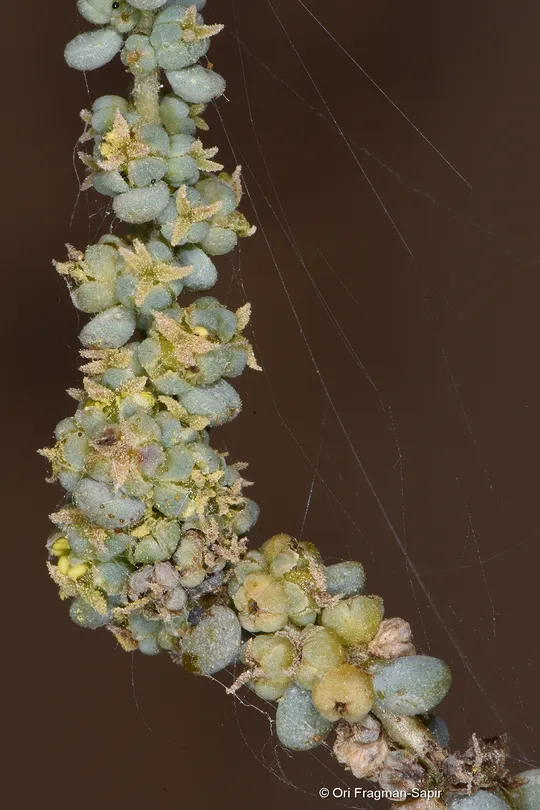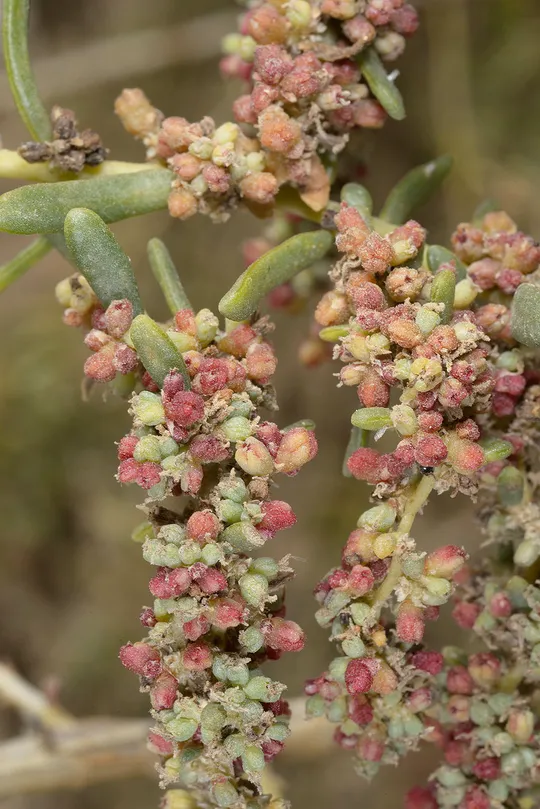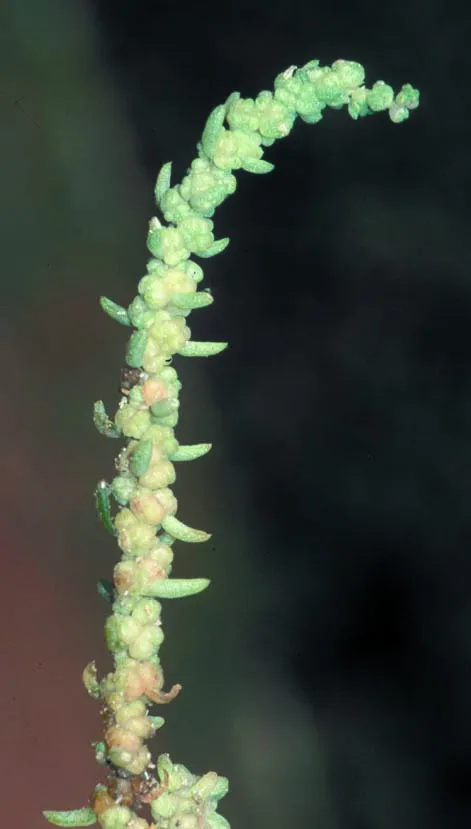Halopeplis amplexicaulis
Halopeplis amplexicaulis once grew in two regions: the Dead Sea and the Acre Valley. It was collected in Israel only twice – at the Kishon estuary in 1951 and at the Sodom salt marsh in 1959. Since then these salt
marshes have undergone drastic changes and most of the H. amplexicauli natural habitats were completely destroyed.
Repeated efforts to rediscover the species in these habitats have
failed and it is probably extinct in Israel.
A typical plant of wet salt marshes that grows both in coastal and interior desert salt marshes.
The genus Halopeplis includes three species found in the Mediterranean Basin, West Asia and South Africa. The
genus belongs to the Chenopodiaceae family in the tribe Salicornieae, which
are characterized by succulent, segmented stems, which grow in wet salt marshes, e.g. Arthrocnemun, Sarcocornia, Halocnemum and Salicornia. The species
in this tribe are very similar in appearance to Haloxylon, Hammada
and Anabasis,
which also have succulent segmented stems. Their flowers however, are androgynous with many stamens, unlike the plants in the Haloxylon group, some of whose flowers are monosexual with only
1-3 stamens in each flower and not 5 as usual. The Haloxylon group exhibits
a tendency for long inflorescences arranged in dense spikelets, probably
"at the expense" of the some
of the flower organs that atrophied and the trend of
monosexuality. The closest genus
to the Halopeplis is Haloxylon, and sometimes Halopeplis is included in this genus. The Haloxylon species that grows in Israel – Salicornia
europaea is also a red species.
·
In the 1950s, Halopeplis amplexicaulis grew on only on two sites and the number of plants is
unknown. Elsewhere in the Levant it grows in dense and even dominant populations,
e.g. in the Azraq marshes in east Jordan.
·
The extinction of the species is almost
certainly due to the changes and the destruction that
occurred in its growing sites – the Kishon salt marsh and the Sedom salt marsh.
Halopeplis amplexicaulis should be
brought from Jordan and
reintroduced to two moist
salt marshes in
Israel –Ne’ot HaKikar, with monitoring and restoration of
its characteristic appropriate water regime, and to the Acre salt marshes or to
the Taninim Stream Nature Reserve.
Halopeplis amplexicaulis
is a widely distributed species in the Mediterranean Basin, penetrating into the Saharo-Arabian
region. In the Mediterranean region it is limited to the sea shore at
the edge coastal salt marshes: Portugal, Spain, Sicily, Italy (absent from the
Balkans), Southern
Turkey, Cyprus,
northwestern Iran, the coast of Egypt and Sinai, Syria (both on the coast and in the Syrian Desert), Libya, Tunisia and the Maghreb countries. The species was first described from Tunisia. It is very common in
the Azraq salt
marshes in Jordan's eastern desert. A dominant species in the Middle East
specifically in the moist desert salt marshes, where there is high, exposed
groundwater all year round. In the literature H. amplexicaulis
is a species whose chorotype center is Mediterranean, but most of its distribution in the Middle East is actually in
desert salt marshes.
Halopeplis
amplexicaulis is proof that it is not sufficient to
declare a nature reserve while
neglecting its water management. H.
amplexicaulis is extinct from the Sodom salt marsh,
within the the Ne’ot
HaKikar area. This area is subject to the
expansion of agricultural areas and suffers severely from over-pumping and
earthworks conducted in the area.
ויזל, י. ואגמי, מ. 1979. צמחי מלֵחה בישראל. הוצאת המדור לאקולוגיה.
Current Occupancy Map
| 1000 squre meter pixel | 5000 squre meter pixel | 10000 squre meter pixel | |
|---|---|---|---|
| number of observations | 0 | 0 | 0 |
| in total pixels | 0 | 0 | 0 |
| Family | Chenopodiaceae |
| Classification | On the episodial species list |
| Ecosystem | Desert |
| Chorotype | Mediterranean and Saharo - Arab |
| Conservation Site | Ne’ot HaKikar Salt Marsh |
| Rarity |
1
5
6
|
|---|---|
| Vulnerability |
0
4
4
|
| Attractiveness |
0
0
4
|
| Endemism |
0
0
4
|
| Red number |
1
-1.0
10
|
| Peripherality | 0 |
| IUCN category | DD EW EX LC CR EN VU NT |
| Threat Definition according to the red book |
 Based on:
Based on:






